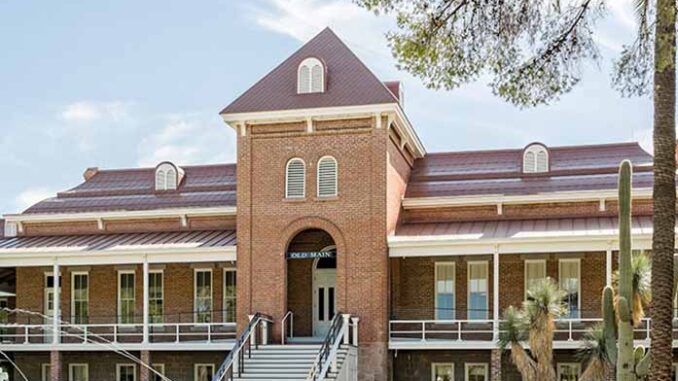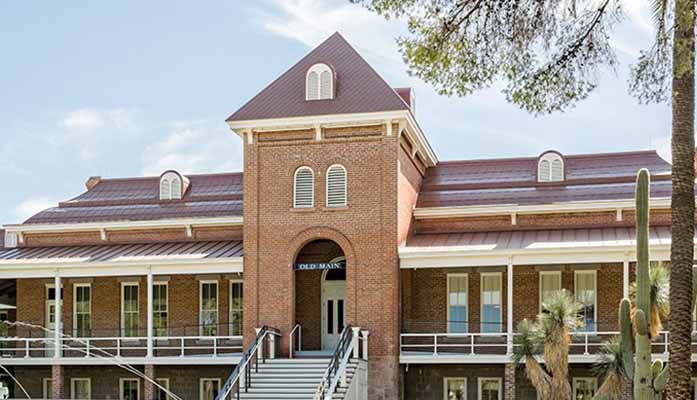
TUCSON – The University of Arizona, which is located in Tucson, has been in turmoil over financial mismanagement, infighting, and the hiring of a new president. At the same time, pronouncements from the university have been chockfull of shopworn words and themes found nationwide, not only on campuses but also in the media and elsewhere.
Most notably, or notoriously, the word “community” is de rigueur. In an example of creative writing, it is used as a work of fiction to put the University of Arizona in a positive light as a community of shared interests and values, where faculty and administrators work cooperatively to advance their proclaimed mission of reaching out to the disadvantaged and minorities, especially Hispanics and indigenous peoples.
Similar fiction is spouted by other universities and is repeated as gospel by the media.
Actually, universities are the antithesis of community. They are ridden with pettiness, backstabbing, jealousies, Machiavellian intrigues, status seeking, and more recently, a fear of being cancelled. They are also places where ill-gotten loot from the tuition loan scam is laundered, with some of it going to subsidize money-losing football programs and gigantic stadiums.
I know this firsthand. When a university provost was a client of my management consultancy, I found an appalling lack of teamwork among the academic and administrative staff.
The latest fatuity to be hatched on campus is “land acknowledgement.” This is spoken at the beginning or in the middle of a proceeding or broadcast, to recognize that it is taking place on what was formerly native land. The local PBS station in Tucson, which is under the stewardship of the University of Arizona, does this during commercial breaks.
What purpose does this hackneyed phrase serve? Does it improve the terrible conditions on most Indian reservations, or nations if you will? Does it reform the dysfunctional Indian Health Service? Does it clarify the mission and authority of the bumbling Bureau of Indian Affairs? Does it tell Americans something that they don’t already know about indigenous peoples being oppressed, and worse, by European settlers?
As with other posturing and virtue signaling, it doesn’t accomplish anything, other than perhaps make the poseurs and signalers feel righteous. Granted, such affectation is much easier than accomplishing real change at personal risk and expense, as I know from being at the leading edge of equal rights over most of my career and having arrows in my back to show for it.
Speaking of arrows, there is no acknowledgment from the local PBS station of the Camp Grant massacre of 1871, which, ironically, happened not far from the University of Arizona campus. That was when the Tohono O’odham tribe massacred Apache women and children while their braves were away.
There are many more obligatory words on campus and in the media than “land acknowledgement,” “community” and “disadvantaged.” Some of the popular ones are: diversity, equity, inclusion, minority, social justice, black, Hispanic, Latino, Latinx, person of color, indigenous, lesbian, bisexual, gay, transexual, transgender, and queer.
Like rubrics in a liturgical service, these words serve as a guide on what is going to follow. Typically, what follows is a formulaic take on the subjects, a take that stresses group victimhood, rationalizes bad behavior, and downplays personal agency and responsibility. For example, a person of color can never be guilty of racism, even if he makes a blatantly racist comment, because a victim can’t be a victimizer.
Stuck in an outdated paradigm, the ideological linguists believe that anyone anointed as a minority by them lacks political power, cultural influence, and a media platform. Thinking that the days of “Father Knows Best” and “Leave It to Beaver” are still here, they don’t realize that the pendulum has been pushed in the other direction with such force that the old cultural norms have been shattered, as is clearly evident in pop culture, media, arts and entertainment, and TV commercials.
Not understanding that excess force from one direction always results in equal force from the other, they are now aghast and puzzled by Trump’s reelection and his MAGA movement.
Even if a topic has nothing to do on the surface with race, ethnicity, class, sexual orientation, or gender, reporters and officials get extra points for weaving their outdated paradigm and lame linguistics into a news story or communique. Take the weather. A recent news story on a heat wave had this angle: Minorities and the disadvantaged are affected more seriously by the heat.
It is never defined what constitutes a minority or a disadvantaged person, but, tellingly, white people are rarely if ever so labeled, even if they are from a tiny ethnocultural group (i.e., Bosnians), and even if they are among the 15 million non-Hispanic whites who live in poverty or among the thousands of homeless white people who roam the streets of America.
At the same time, with the exception of white Hispanics, whites are stereotyped as racists, colonialists, imperialists, oppressors, supremacists, and, to top it off, privileged, and fragile.
The underlying premise is that whites are not only homogeneous in race, ethnicity, and social class, but also share the same attitudes, values, and history.
Of course, that’s absolute nonsense, as professors of genetics, ethnography, sociology, anthropology, and history know.
They also know:
– that the official racial categories of White, Black, Hispanic (or Latino), Asian, Native American, and the newest addition, Middle Eastern, are mostly social constructs and political inventions, with little basis in science;
– that the six are not discrete categories, since they overlap considerably, since there is intermarriage between them, and since there is nearly as much racial, ethnic and class diversity within each category as there is between the categories;
– that the good, bad and ugly of human nature is universal and that all of the hundreds of subgroups in all of the categories, either historically or currently, have engaged in brutality, butchering, conquering, and subjugating;
– that those who have done so more recently are remembered more vividly and resented more strongly than those who committed their evils longer ago, but distance doesn’t make the older evils less evil;
– that groups characterized as minorities and victims tend to be vilified less than whites, even when they have committed injustices to the same or greater degree, such as the fact that Hispanics brought considerably more slaves to the Americas than did the English and Dutch; and
– that certain subgroups in the White category have been subjected to injustices, either in America or their ancestral homelands, such as the eleven Italians lynched in New Orleans in 1891, the Immigration Act of 1924 that was enacted to stem the flow of “inferior” emigrants from Italy and other parts of southern Europe, the genocide committed against Armenians by the Ottoman Empire in 1915, and the ethnic cleansing of Christian Armenians by Muslims in Azerbaijan in 2023.
College professors know all of this and more, but you wouldn’t know it from the linguistic lobotomies that are performed on gullible students, especially by DEI departments, where Armenians and other whitish minorities are excluded from DEI initiatives because they look white.
The affectation has spread far and wide, including to museums. Take the Pima Air and Space Museum in Tucson. A few years ago, a curator put up a display that featured several “Hispanic” fighter pilots from the Second World War. No doubt, this reflected the belief that so-called minorities should be singled out and spotlighted positively, because, for centuries, the white majority ignored them or stereotyped them negatively, in not only museums but also the news media, literature, the arts, and even advertisements.
There are two problems with this. First, “Hispanic” can mean just about anything, given that it is a broad term that encompasses so many races, ethnocultural groups, and nationalities. Second, the white majority isn’t really a majority, considering that it consists of many minority groups, especially the ones formerly known as “ethnics.” Being outside of the White Anglo-Saxon Protestant majority, these ethnic groups were shunned and stereotyped negatively for much of the nation’s history.
My ethnic group of Italian was one of them. Italians were not considered white until well into the twentieth century and then were stereotyped as gangsters.
Were there any Italian-American fighter pilots in WWII? Any generals or admirals? I don’t know of any. I do know, however, that my dad served as a lowly Navy seaman in in the Pacific theatre during the war and is buried in a veteran’s cemetery. As an example of the benefits of assimilation, this third-generation son would attain the rank of captain in the Army.
It would be off-putting to me if there were a display featuring only Italian pilots. I would wonder why they were being singled out and would find it to be patronizing and a subtle form of racism, perhaps reflecting a curator’s surprise that Italians would have the intelligence to fly an airplane.
Incidentally, my dad and mom grew up in a real community, not a fairytale one—namely, the Italian section of St. Louis that is known as the Hill, because it sits on a hill. It was known as Dago Hill well into my teens.
It was very safe and very clean. The tiny shotgun houses and flats, with their tiny front yards and vegetable gardens and arbors in the backyard, were kept in immaculate condition. The parish church and school were the center of the community, and a statue of a poor immigrant family carrying all of their possession in a couple of valises still stands in front of the church.
It was a walkable community before “walkable” became a trendy word. Residents would walk to neighborhood bakeries, delicatessens, restaurants, community centers, and taverns, many of which had a bocci alley in back. In the early years, men would carry lunch pails to their jobs in nearby clay mines or to factories that used the clay to make bricks and sewer pipes. They worked ten hours a day, six days a week.
The most popular sports for kids were soccer and baseball. Regarding the former, five soccer players from the Hill played on the US World Cup team that beat England for the World Cup Championship in 1950. Regarding the latter, the Hill produced baseball notables Yogi Berra and Joe Garagiola.
The Hill was close-knit, self-contained, and self-reliant, with its own institutions and social-welfare associations, largely independent of the WASP majority that ran the city.
It was the opposite of today’s universities, where students learn a sophomoric and statist view of social issues and are steeped in clichés, platitudes, pieties, banalities, buzzwords, slogans, sophistries, and nostrums about community, social justice, and diversity, equity and inclusion. Then, after graduation, believing that they are worldly and wise, they take these words and themes to their jobs in media, government, industry, the arts, and museums.
A final word comes to mind: stupido.
Mr. Cantoni can be reached at craigcantoni@gmail.com.

